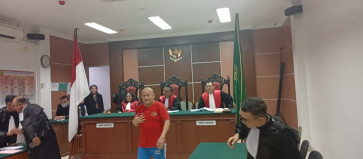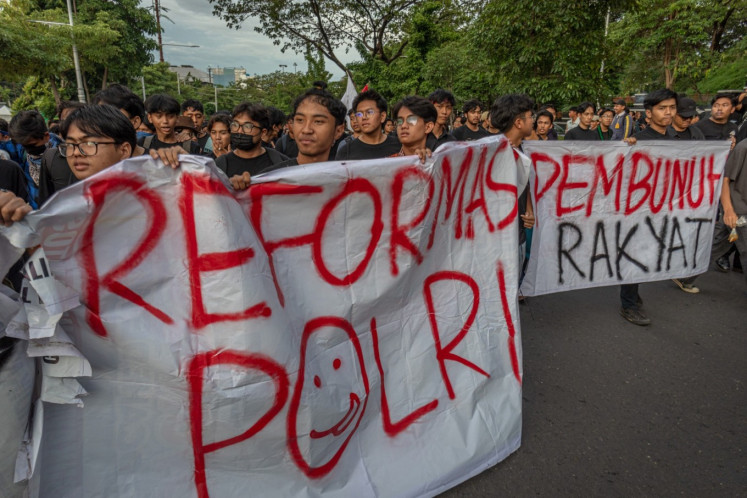Popular Reads
Top Results
Can't find what you're looking for?
View all search resultsPopular Reads
Top Results
Can't find what you're looking for?
View all search resultsDwi Cahyono: Putting history in its place
DWI CAHYONO: (Courtesy of Dwi Cahyono)Dwi Cahyono firmly believes that history does not have to be stuffy and old-fashioned
Change text size
Gift Premium Articles
to Anyone
DWI CAHYONO: (Courtesy of Dwi Cahyono)Dwi Cahyono firmly believes that history does not have to be stuffy and old-fashioned. The entrepreneur and art lover wants to bring relics of the past into the here and now.
In 2004, he opened Inggil restaurant and museum, his homage to Malang through the ages. Archival photos of key moments in the East Java mountain town's history adorn its walls, and Javanese masks stand amid antiques and knickknacks, including a curious collection of transistor radios and an old hair perming machine.
Still it takes some persuading to convince many Indonesians, still traumatized by mind-numbing school field trips to dark, dusty and decrepit museums, that history is not boring.
"We all know the state of museums in Indonesia today, there is not much attention given to them and people don't want to go there," Dwi, 40, said Wednesday night at the restaurant, located in a leafy suburb near the town's famous Tugu independence monument and City Hall.
"So I thought, let's bring the museum to them. Let's open a place, either a hotel or restaurant, where people can also learn."
A couple of years ago, he decided to put history on the street, literally and figuratively. His Malang Kembali (A Return to Old Malang) event, held on the city's elite Jl. Ijen, was a historical showcase, with vendors offering traditional snacks and entertainment. The only requirement for entry was the donning of traditional attire.
He says the event attracted people of all ages, including teens who gave a concert by popular rock group Slank a miss.
"It's a shortcut to learn about history. And it turned out that people really wanted to know more, there was a longing to learn about the past. People came the first day, and then they came back the second, and then the third."
The closure of Jl. Ijen, the spacious boulevard once favored by Dutch colonists, originally led to opposition among some of the street's residents.
"I reminded them that Jl. Ijen was once an all-Dutch residential area and that hundreds of freedom fighters lost their lives in June 1947 to take back the area," said Dwi, who is currently preparing the next four-day Malang Kembali in May.
"I said they now get to enjoy Jl. Ijen every day, so couldn't they let the public, whose forefathers lost their lives in the name of freedom, enjoy the street for a few days. They agreed and things are very good now. Some of them also open stalls for the event."
From a military family, Dwi says his parents loved the arts and he studied dance from childhood. He received a business degree in Australia but says cultural activities remained his great love.
"I played in a band when I was a teen, but there was always that calling to traditional culture. After I returned from Australia, I realized that historical objects are revered abroad, while here they are neglected, left on the side of the street or in the middle of a rice field."
He built several successful businesses -- a maternity hospital, travel agent, restaurant and boutique -- and began collecting historical objects on the side. He then had the idea of founding Inggil, serving traditional food such as Javanese fried chicken and pecel (blanched vegetables in peanut sauce) in an 85-year-old Dutch house where pieces of history are at every turn.
"People were quite shocked when we first opened, they thought it was a bit strange," says Dwi, whose family owns a famed nasi rawon (Javanese beef stew) restaurant, Nguling.
They came and learned. One of the photo displays shows a youthful-looking Sukarno inaugurating the Tugu Monument in 1953.
"I would say that 50 percent of people in Malang didn't know that president Sukarno had come here. So it made them proud when they saw the pictures."
The restaurant is open in the morning for school field trips, but the father of three says it's understandable if students remain averse to history.
"It's not their fault. It's because the cultural institutions like museums don't try to bring them in, in a way that they understand. It's not that they don't care, it's because they don't know and have only received information in that old-fashioned way; 'this is an old object from the such and such era'."
For the iPod-listening, digital camera-toting generation, he has put together a multimedia cartoon presentation for distribution by SMS. "It's how we convey something that matters. If it's not conveyed right, then it won't reach them."
In recent years, there has been a growing appreciation of ethnic handicrafts and design among the upwardly mobile in Indonesia, although sometimes there is little thought about form and function.
"There needs to be an educative element to it as well, not just about putting something ethnic there," he said. "For example, Javanese carved wooden entranceways have a sacred function; they were used by noble families for particular parts of the home, such as where the head of the household lived.
"But in some places they are put next to the toilet. People who know such matters would consider it to be denigrating to their historical tradition."
Although many old buildings have been demolished in the name of development in cities around Indonesia, a stroll around Malang reveals well-kept Dutch-era bungalows, military facilities and shop-houses (Malang is a favorite stop for tourists from the Netherlands).
Dwi documented many of the structures -- in historical photos and shots of them today -- in his recently published guidebook Menelusuri Dengan Hati (Exploring with The Heart).
Dwi, who is also the vice chairman of the East Java branch of the Indonesian Hotel and Restaurant Association and director of the Malang Arts Council, is a pragmatist, knowing that development cannot be stopped in a city whose population is now nearing 800,000.
"What I really regret is when the function of an old building is changed, because it can still be used even today."
He says Malang's history can be its selling point, a refreshing difference from other rapidly urbanized and chaotic cities. More importantly, he said, Indonesians can learn to be proud of who they are through knowing their history.
"My hope is not only for Malang, but for all of Indonesia's young generation. I want them to really understand who they are. We are Indonesians. When we know who we are, where we came from, then we will know our deficiencies and our strengths ... And once we know who we are, it's then that we will be able to advance."










